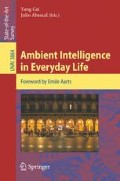Abstract
The classical approach to improve human-machine interaction is to make machines seem more like us. One very common way of doing this is to try to make them able to use Human Natural Languages. The trouble is that current speech understanding techniques do not work well in uncontrolled and noisy environments, such as the ones we live and work in. Nor do these attempts mean that the machines use our languages in the way we do: they typically don’t speak much like we do, and we mostly have to speak to them in special unnatural ways for them to be able to understand. Rather than require people to adapt how they speak to machines, so that the machines can understand them, we present a simple artificial language, based upon musical notes, that can be learned and whistled easily by most people, and so used for simple communication with robots and other kinds of machines that we use in our everyday environments.
Access this chapter
Tax calculation will be finalised at checkout
Purchases are for personal use only
Preview
Unable to display preview. Download preview PDF.
References
Allen, J.: How Do Human Process and Recognize Speech. IEEE Transactions on Speech and Audio Processing ASP 2, 567–577 (1994)
Alonso, J.M.: TCP/IP. Programación the aplicaciones distribuidas. ra-ma (1998)
Alty, J.L.: Can we use music in computer-human communication. In: Proceedings of HCI 1995, pp. 409–423 (1995)
American Acoustic Society octave designation system: http://www.music.vt.edu/musicdictionary/texto/Octavedesignation.html
Blattner, M.M., Sumikawa, D.A., Greenberg, R.M.: Earcons and icons: Their structure and common design principlles. In: Human-Computer Interaction (1989)
Bohlen, M.: Universal Whistling Machine, http://www.realtechsupport.org/new_works/uwm.html , See also, Bohlen, M., Rinker, J.T.: Concurso Internacional sobre Arte y Vida Artificial, U.W.M (2004), http://www.fundacion.telefonica.com/at/vida/paginas/v7/whistling.html
Brigham, E.O.: The fast Fourier transform and its applications. Prentice-Hall, Inc., Englewood Cliffs (1988)
Brewster, S.A.: Providing a structured method for integrating non-speech audio into human-computer interfaces. PhD Thesis, University of York, UK (1994)
Brewster, S.A., Wright, P.C., Edwards, A.D.N.: An evaluation of earcons for use in auditory human-computer interfaces. In: Proceedings of InterCHI 1993 (Amsterdam), pp. 222–227. ACM Press, Addison-Wesley (1993)
Cutnell, J.D., Johnson, K.W.: Physics, 6th edn. Wiley, New York (2004)
Esnaola, U., Rañó, I., Smithers, T.: Robot MiReLa: Helping the Secretary to Attend Visitors. In: Proceedings of 2nd International Workshop on Advances in Service Robots (ASER 2004), May 20–21, 2004, Fekdafing, Lake Starnberg, Germany (2004)
Esnaola, U., Rañó, I., Smithers, T.: A Behaviour-Based Navigation System. In: Proceedings of TAROS 2004, September 2004, University of Essex, England (2004)
Esnaola, U., Smithers, T.: MiReLa: A Musical Robot. In: 6th IEEE International Symposium on Computational Intelligence in Robotics and Automation (CIRA 2005), Helsinki University of Technology, June 27–30, 2005, Espoo, Finland (accepted, 2005)
Gray, W.D.: VCR-as-paradigm: A study and taxonomy of errors in an interactive task. In: Nordby, K., Helmersen, P., Gilmore, D.J., Arnesen, S.A. (eds.) Human-Computer Interaction—Interact 1995, pp. 265–270. Chapman & Hall, New York (1995)
Gomera: see Whistled Speech. Wikipedia, http://wikimediafoundation.org/wiki/WhistledSpeech/
Husband, G.: What’s in your Music (1999), http://www.tnt-audio.com/topics/frequency_e.html
Karolyi, O.: Introducing Music. Penguin Books (1965)
Karu, Z.: Signals and systems. Made Ridiculously simple. ZiZi Press (1995)
Leplatre, G., Brewster, S.A.: Perspectives on the Design of Musical Auditory Interfaces. Focus conference on Anticipation, Cognition and Music. Liege, Belgium (August 1998); In: Dubois, D., (ed.) International Journal of Computing Anticipatory Systems (February 1999)
MICROPIK: PS6E8S, manual de instructiones. Profesor Blanco 18 Bajos, 46014-Valencia, Spain (2003)
Minsky, M.: The Society of Mind, Wiliam Heineman Ltd (1987)
NORCOMM: Model NC400 Touch-tone ani/alarm encoder instruction manual. 15385 Carrie Drive, Grass Valley, CA 95949 (2004)
Pierce, J.R.: The Science of Musical Sound. Scientific American Books. W. H. Freeman and Company, New York (1983)
Rañó, I.: Investigación de una arquitectura basada en el comportamiento para robots autónomos en entornos semi-estructurados, PhD Thesis, Facultad de Informática, Universidad del país Vasco (UPV) (2004)
Tristan, R.M.: Zapatero se compromete a duplicar la inversión en I+D+i para el año 2010. El Mundo (June 2005)
Smoloiar, W.: The role of music in multimediam. IEEE Multimedia, 9–11 (1994)
Vicker, P., Alty, J.L.: Siren Songs and Swan Songs, Debugging with Music. Communications of the ACM 46(7), 87–92 (2003)
Author information
Authors and Affiliations
Editor information
Editors and Affiliations
Rights and permissions
Copyright information
© 2006 Springer-Verlag Berlin Heidelberg
About this chapter
Cite this chapter
Esnaola, U., Smithers, T. (2006). Whistling to Machines. In: Cai, Y., Abascal, J. (eds) Ambient Intelligence in Everyday Life. Lecture Notes in Computer Science(), vol 3864. Springer, Berlin, Heidelberg. https://doi.org/10.1007/11825890_10
Download citation
DOI: https://doi.org/10.1007/11825890_10
Publisher Name: Springer, Berlin, Heidelberg
Print ISBN: 978-3-540-37785-6
Online ISBN: 978-3-540-37788-7
eBook Packages: Computer ScienceComputer Science (R0)

